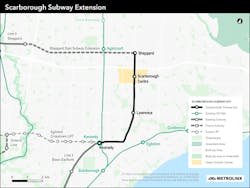RFQ issued for Scarborough Subway Extension stations and rail package
Procurement has begun on the second major contract for the Scarborough Subway Extension project with the release of a Request for Qualifications (RFQ) by Infrastructure Ontario (IO) and Metrolinx looking for interested teams to design and build the Stations, Rail and Systems (SRS) package for the project.
The project will extend the Toronto Transit Commission’s (TTC) Line 2 by 7.8 kilometers (4.85 miles) into Scarborough and the province is pursuing two separate contracts for the project to speed construction. A contract to design, build and finance the extension’s tunnel was awarded to Strabag AG in May 2021 and a ground-breaking ceremony for the project was held in June 2021.
“The release of this procurement package for the Scarborough Subway Extension marks another milestone reached on [Ontario] Premier [Doug] Ford’s transit expansion plan for the people of Scarborough and the [Greater Toronto Area],” said Caroline Mulroney, Ontario Minister of Transportation. “Each project milestone we achieve demonstrates our government’s unwavering commitment to building a world-class, efficient rapid transit network that will cut through congestion, reduce greenhouse gas emissions and get people to where they need to go faster.”
The RFQ outlines the contract’s scope of work including:
- Three new subway stations, with associated bus terminal facilities;
- Eight emergency exit buildings and other required emergency and life-safety facilities;
- Transition section between Kennedy Station and the tunnel boring machine extraction shaft at Eglinton Avenue East and Midland Avenue;
- Installation, testing and commissioning of all systems equipment including track, ventilation, signals, communications, integrated control system, traction power and all other permanent mechanical and electrical systems;
- Four traction power substations; and
- Integration with TTC infrastructure at Kennedy Station, as well as with the advance tunnel infrastructure works.
IO and Metrolinx say the SRS package is being delivered using a progressive design build delivery model where a “development partner” will be selected to work collaboratively with IO and Metrolinx during a design phase before finalizing the design-build contract.
"We are making important progress on delivering modern and reliable rapid transit for Scarborough by starting procurement for the Stations, Rail and Systems contract. Securing a team of skilled industry leaders to complete this major part of the project will help us get the extension completed as quickly as possible for transit riders in Scarborough and around the region,” said Metrolinx President and CEO Phil Verster.
Metrolinx is planning for each station on the three-stop Scarborough Subway Extension to be important transport hubs that connect to surface routes, helping passengers to move seamlessly through a broader transit network.
“Scarborough has a wide geographic area and large parts of Scarborough rely on buses to get to the subway,” said Michael Hodge, program sponsor. “We are building stations that will be important connection points, with buses coming in from all parts of Scarborough.”
IO and Metrolinx will evaluate submissions and expect to announce a shortlist of qualified proponents who will be invited to respond to a request for proposals in early 2022.
"Infrastructure Ontario is pleased to be a part of building new transit infrastructure in the city of Toronto, helping bring much-needed relief to commuters and families. The release of the RFQ for the Stations, Rail and Systems work is an important step towards getting a partner on board to help us deliver the Scarborough Subway Extension," said Infrastructure Ontario President and CEO Michael Lindsay.
About the Author

Mischa Wanek-Libman
Group Editorial Director
Mischa Wanek-Libman is director of communications with Transdev North America. She has more than 20 years of experience working in the transportation industry covering construction projects, engineering challenges, transit and rail operations and best practices.
Wanek-Libman has held top editorial positions at freight rail and public transportation business-to-business publications including as editor-in-chief and editorial director of Mass Transit from 2018-2024. She has been recognized for editorial excellence through her individual work, as well as for collaborative content.
She is an active member of the American Public Transportation Association's Marketing and Communications Committee and served 14 years as a Board Observer on the National Railroad Construction and Maintenance Association (NRC) Board of Directors.
She is a graduate of Drake University in Des Moines, Iowa, where she earned a Bachelor of Arts degree in Journalism and Mass Communication.
